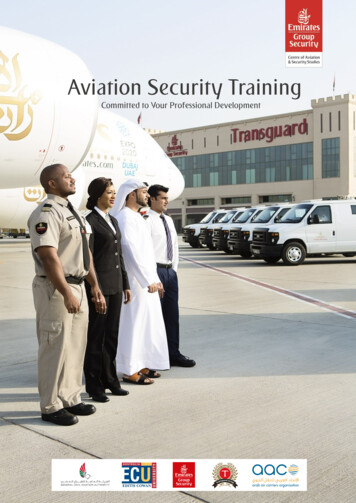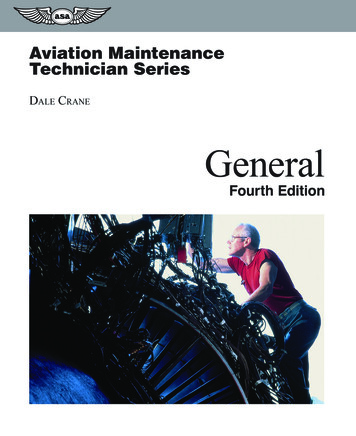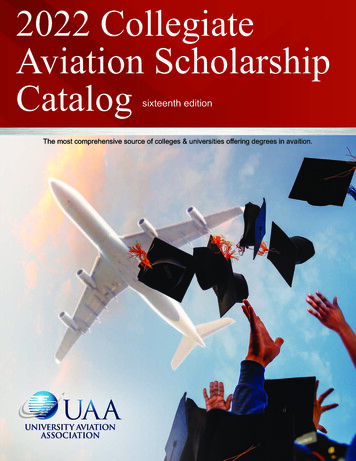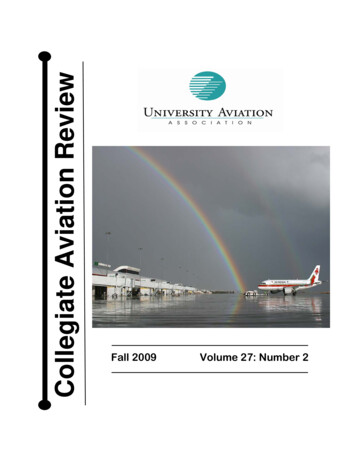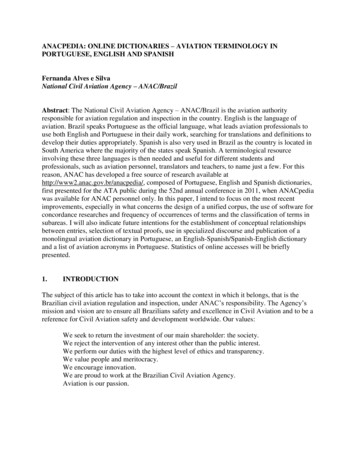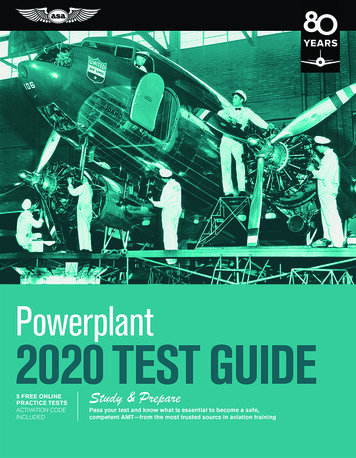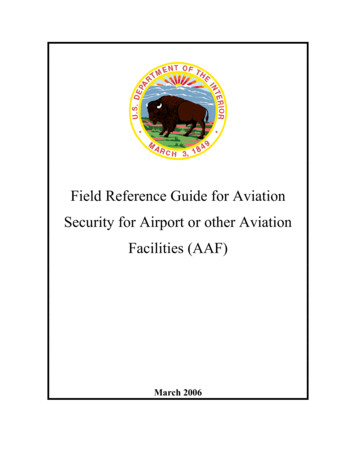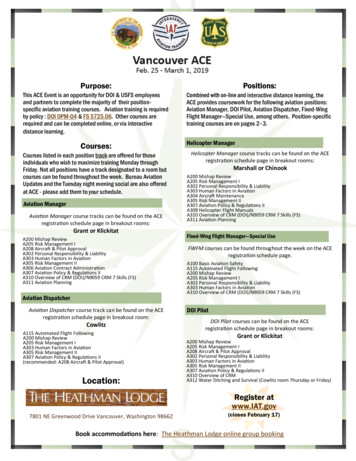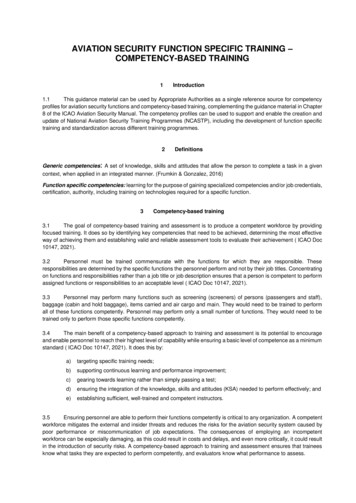
Transcription
AVIATION SECURITY FUNCTION SPECIFIC TRAINING –COMPETENCY-BASED TRAINING1Introduction1.1This guidance material can be used by Appropriate Authorities as a single reference source for competencyprofiles for aviation security functions and competency-based training, complementing the guidance material in Chapter8 of the ICAO Aviation Security Manual. The competency profiles can be used to support and enable the creation andupdate of National Aviation Security Training Programmes (NCASTP), including the development of function specifictraining and standardization across different training programmes.2DefinitionsGeneric competencies: A set of knowledge, skills and attitudes that allow the person to complete a task in a givencontext, when applied in an integrated manner. (Frumkin & Gonzalez, 2016)Function specific competencies: learning for the purpose of gaining specialized competencies and/or job credentials,certification, authority, including training on technologies required for a specific function.3Competency-based training3.1The goal of competency-based training and assessment is to produce a competent workforce by providingfocused training. It does so by identifying key competencies that need to be achieved, determining the most effectiveway of achieving them and establishing valid and reliable assessment tools to evaluate their achievement ( ICAO Doc10147, 2021).3.2Personnel must be trained commensurate with the functions for which they are responsible. Theseresponsibilities are determined by the specific functions the personnel perform and not by their job titles. Concentratingon functions and responsibilities rather than a job title or job description ensures that a person is competent to performassigned functions or responsibilities to an acceptable level ( ICAO Doc 10147, 2021).3.3Personnel may perform many functions such as screening (screeners) of persons (passengers and staff),baggage (cabin and hold baggage), items carried and air cargo and main. They would need to be trained to performall of these functions competently. Personnel may perform only a small number of functions. They would need to betrained only to perform those specific functions competently.3.4The main benefit of a competency-based approach to training and assessment is its potential to encourageand enable personnel to reach their highest level of capability while ensuring a basic level of competence as a minimumstandard ( ICAO Doc 10147, 2021). It does this by:a)targeting specific training needs;b)supporting continuous learning and performance improvement;c)gearing towards learning rather than simply passing a test;d)ensuring the integration of the knowledge, skills and attitudes (KSA) needed to perform effectively; ande)establishing sufficient, well-trained and competent instructors.3.5Ensuring personnel are able to perform their functions competently is critical to any organization. A competentworkforce mitigates the external and insider threats and reduces the risks for the aviation security system caused bypoor performance or miscommunication of job expectations. The consequences of employing an incompetentworkforce can be especially damaging, as this could result in costs and delays, and even more critically, it could resultin the introduction of security risks. A competency-based approach to training and assessment ensures that traineesknow what tasks they are expected to perform competently, and evaluators know what performance to assess.
4Knowledge, skills and attitudes ( ICAO Doc 10147, 2021)4.1Knowledge. Knowledge is specific information required to enable a learner to develop and apply the skillsand attitudes to recall facts, identify concepts, apply rules or principles, solve problems, and think creatively in thecontext of work. Knowledge is an outcome of the learning process, whether learning occurs in formal or informal. Thereare different types of knowledge: declarative (e.g. facts and raw data), procedural (e.g. categorized/contextualized andapplication of conditional if-then rules), strategic (e.g. synthesis, inference to guide resource allocation for decisionmaking, problem solving and behavioural action), and adaptive (e.g. generalization, innovation, and invention).4.2Skills. A skill is an ability to perform an activity or action. It is often divided into three types: motor, cognitiveand metacognitive skills. A motor skill is an intentional movement, involving a motor or muscular component, that mustbe learned and voluntarily produced to proficiently perform a goal-oriented task. A cognitive skill is any mental skill usedin the process of acquiring knowledge, such as reasoning, perception and intuition. A metacognitive skill relates to theability of learners to monitor and direct their own learning processes (“thinking about thinking”); for example, planninghow to approach a given learning task, monitoring comprehension and evaluating progress toward the completion of atask.4.3Attitudes. Attitude is a persistent internal mental state or disposition that influences an individual’s choice ofpersonal action toward some object, person or event and that can be learned. Attitudes have affective components,cognitive aspects and behavioural consequences. To demonstrate the “right” attitude, a learner needs to “know how tobe” in a given context.5Principles of competency-based training and assessment5.1A competency-based approach to training and assessment is based on the following principles ( ICAO Doc10147, 2021):a)relevant competencies are clearly defined for a particular role;b)there is an explicit link between competencies and training, required performance on the job, andassessment;c)competencies are formulated in a way that ensures they can be trained for, observed and assessedconsistently in a wide variety of work contexts for a given role;d)trainees successfully demonstrate competency by meeting the associated competency standard;e)each stakeholder in the process including the employer instructor, trainee, training organization andAppropriate Authority has a common understanding of the competency standards;f)clear performance criteria are established for assessing competence;g)evidence of competent performance is valid and reliable;h)instructors’ and assessors’ judgements are calibrated to achieve a high degree of inter-rater reliability;i)assessment of competencies is based on multiple observations across multiple contexts; andj)to be considered competent, an individual demonstrates an integrated performance of all the requiredk)competencies to a specified standard.6Aviation security functions and responsabilities6.1This paragraph contains the identification of aviation security functions or responsibilities of the aviationsecurity personnel.
Table 6-1. List of aviation security functions and responsibilities of the aviation security personnel.Categories1. Security 1 Airport SecurityManagers1.1.1. Person with general responsibility at local levelfor ensuring that the airport security programme andits implementation meet all legal provisions.1.2 Air Carrier SecurityManagers1.2.1. Person with general responsibility for ensuringthat the air carrier security programme and itsimplementation meet all legal provisions.1.3. Cargo SecurityManagers (Regulated Agentand Known Consignors)1.3.2 Known Consignor Security Manager: Person ateach site who shall be responsible for the applicationand supervision of the implementation of securitycontrols at that site.1.4 In-flight and AirportSuppliers Security Managers1.4.1 Person at each site who shall be responsiblefor the application and supervision of theimplementation of security controls applied by anapproved in-flight supplier or an approved airportsupplier.1.5 Security managers ofother entities responsible forimplementing securitymeasures1.5.1 Person who shall be responsible for theapplication and supervision of the implementation ofsecurity controls.2. Supervisors3. Screeners1.3.1. Regulated Agent Security Manager: Person ateach site who shall be responsible for theimplementation of the submitted regulated agentsecurity programme and its implementation meet alllegal provisions.2.1 Persons directly supervising persons (screenersand other security staff) implementing securitycontrols.3.1 Screeners - persons,baggage, items carried.3.1.1 Persons implementing screening of persons(passengers and staff), baggage (cabin and holdbaggage) and items carried.3.2 Screeners – Cargo andMail3.2.1 Persons implementing screening of cargo andmail.3.3 Screeners – in-flightsupplies, airport supplies, aircarrier mail and materials.3.3.1 Persons implementing screening of in-flightsupplies, airport supplies, air carrier mail andmaterials.4. Access Control of Persons (passengers andstaff) and Vehicles5. Examination of Vehicles6. Surveillance and Patrols4.1 Persons implementing access control of personsand vehicles.5.1 Persons performing vehicle examinations.6.1 Persons implementing surveillance and patrols.
7.1 Aircraft Search7. Aircraft Security7.2 Aircraft Protection7.3 In-flight Security8. Hold baggage Reconciliation9. Security controlsother than screening7.1.1 Personssearches.implementingaircraftsecurity7.2.1 Persons implementing aircraft protection.7.3.1 ersonsreconciliationimplementingholdbaggage9.1 Cargo and Mail9.1.1 Persons implementing security controls forcargo and mail other than screening.9.2 In-flight supplies, airportsupplies, air carrier mail andmaterials.9.2.1 Persons implementing security controls for aircarrier mail and materials, in-flight supplies andairport supplies other than screening.10. Instructors10.1 Persons developing and/or delivering aviationsecurity training.11. Inspectors and Auditors11.1 Persons conducting a range of inspections andaudit activities to ensure aviation securitycompliance, quality control and oversight activities.6.2The list in the Table 6-1, should be considered as a reference. States can add additional functions orresponsabilities as identified by the State and/or the appropriate authority.7Aviation security competency profiles7.1The Aviation Security Function Mapping Table (Attachment A to Appendix 8) defines for each specific functiona required competency profile composed by a generic competencies and function specific competencies to performassigned functions or responsibilities to an acceptable level.7.2The Aviation Security Function Mapping Table (Attachment A to Appendix 8) groups main function togetheras categories, before splitting these down into sub-categories and specific functions or responsibilities. This allows thedocument to be used as a reference tool for reviewing the training targeted for specific functions or responsibilities,whilst harmonizing the training across all functions through the use of standardized competencies.7.3The generic and function specific competencies defined int the Aviation Security Function Mapping Table(Attachment A to Appendix 8), should be considered as a minimum reference. States can add additional competenciesas identified by the State and/or the appropriate authority.8Development of aviation security function specific training based on competency profiles8.1The development of function specific training across the different categories and sub-categories should ensurethat, at the end of the training completion, all personnel is competent to perform their assigned function s to anacceptable level.8.2For persons performing more than one specific function the development of training should take inconsideration the equivalence between the generic and function specific competencies of each category or sub-1Not applicable to in-flight security officers, for information on criteria refer to Chapter 12, paragraph 12.4.
category. For example, the development oftraining for personnel who performs screening (screeners) of persons(passengers and staff), baggage (cabin and hold baggage), items carried and air cargo and mail should take intoconsideration the following equivalences between competencies:Equivalence between competencies3.1 Screeners of persons (passengers and staff),baggage (cabin and hold baggage),3.2 Screeners or air cargo and mail3.1a)-3.2a); 3.1b)-3.2b); 3.1f)-3.2c); 3.1e)-3.2d); 3.1i)3.2e); 3.1j)-3.2f); 3.1m)-3.2h); 3.1n)-3.2i); 3.1o)-3.2j);3.1q)-3.2n); 3.1r)-3.2o); 3.1t)-3.2p); 3.1u)-3.2q);3.1x)-3.2t)Legend: Equivalent competencies; Partially equivalent competenciesExample pair of equivalence: 3.1a)-3.2a); the numbers are the sub-categories and the letters are the competenciesreferring to each sub-category.8.3For the example above, the function specific training for screeners of persons (passengers and staff), baggage(cabin and hold baggage), items carried and air cargo and mail should be based on competency profiles composed byof all competencies listed in sub-categories 3.1 and 3.2 and should not repeat the competencies mentioned in the pairsof equivalences, only one of the competencies in each pair should be considered.8.4For partially equivalent competencies the training should be adapted to the specificities of each specificfunction. Partially equivalent competencies of functions of greater complexity and/or responsibility may be consideredas equivalent competencies in relation to functions of less complexity, for example the equivalence between theSecurity Managers and Supervisors or Supervisors and persons to be supervised.8.5All pair of equivalences between all categories and sub-categories listed in the Aviation Security FunctionMapping Table (Attachment A to Appendix 8) are identified in the Matrix of Equivalences (Attachment B to Appendix8).8.6More information about the development of a training program, can be found in the paragraph 8.3.2 of theChapter 8.ReferencesICAO Doc 10147. (2021). Guidance on a Competency-based Approach to Dangerous Goods Training andAssessment DOC 10147 (First Edition ed.). Montreal, Canada: ICAO.Frumkin, R., & Gonzalez, K. (2016). Handbook of Research on Effective Communication in CulturallyDiverse Classrooms. Harrisburg, PA, United States: Idea Group,U.S.
AVIATION SECURITY FUNCTION MAPPING itiesRequired competency profileGeneric competencies1.1 Airport SecurityManagers1.2 Air Carrier SecurityManagers1.3. Cargo SecurityManagers (RegulatedAgent and KnownConsignors)1. SecurityManagers1.4 In-flight and AirportSuppliers SecurityManagers1.1.1. Person with general responsibility atlocal level for ensuring that the airport securityprogramme and its implementation meet alllegal provisions.1.2.1. Person with general responsibility forensuring that the air carrier securityprogramme and its implementation meet alllegal provisions.1.3.1. Regulated Agent Security Manager:Person at each site who shall be responsiblefor the implementation of the submittedregulated agent security programme and itsimplementation meet all legal provisions.1.3.2 Known Consignor Security Manager:Person at each site who shall be responsiblefor the application and supervision of theimplementation of security controls at that site.1.4.1 Person at each site who shall beresponsible for the application and supervisionof the implementation of security controlsapplied by an approved in-flight supplier or anapproved airport supplier.a)Relate to the impact of previous acts of unlawful interference against civil aviation,including but not limited to current and evolving threats;b)Be able to interpret and apply the aviation security legislative framework and relateto aviation security programmes, including the understanding of the obligations andresponsibilities of persons implementing security controls, including those in thesupply chain (cargo, inflight and airport supplier security managers);c)Explain access control systems, processes and procedures;d)Produce risk assessments and implement mitigation strategies to manage risk;e)Apply conflict management and decision-making skills;f)Outline and apply procedures for challenging persons and of circumstances in whichpersons should be challenged or reported;g)Outline and apply reporting procedures in accordance with local and nationalrequirements;h)Associate how human behavior and responses can affect security performance;i)Apply clear and confident communication techniques in writing, speaking, listeningand gesturing;j)Demonstrate project management, financial and human resources skills, includingselection criteria and recruitment principles;k)Be able to lead, manage and motivate others;l)Identify elements to the establishment of a robust and resilient security culture in theworkplace, security campaigns and awareness training;m) Identify prohibited articles;1.5 Security managers ofother entities responsiblefor implementing securitymeasures1.5.1 Person who shall be responsible for theapplicationandsupervisionoftheimplementation of security controls.n)Describe and recognize how prohibited articles may be concealed; ando)Identify and address insider threats by conducting risk assessments.Function specific competenciesAirport Security Manager:p)Knowledge of oversight management of safeguards and security controlprocedures;q)Working knowledge of screening requirements, configurations of screeningcheckpoints and screening process, capabilities and limitations of securityequipment and/or screening methods used;
r)Required competency profileBe able to interpret and apply internal, national, regional and international qualitycontrol measures;s)Apply security incident management principles and apply them in, contingencyplanning and security exercises;t)Be able to detect, prevent, respond and recover from security related incidents; andu)Ability to interpret and apply requirements for Security Tamper Evident Bags(STEBs).Air Carrier Security Manager:v)Demonstrate knowledge of principles of hold baggage reconciliation and documentverification procedures;w) Define measures for aircraft protection and searching processes;x)Demonstrate knowledge on threat risk assessment, response procedures andincident management;y)Apply and explain processes and procedures in respect to inflight security andinflight supplies, catering and cargo and mail;z)Apply and explain procedures for carriage of firearms;aa) Ability to interpret and apply requirements for Security Tamper Evident Bags(STEBs); andbb) Be able to detect, prevent, respond and recover from security related incidents.Cargo and Known Consignor Security Managerscc) Identify the principles and processes of secure supply chain;dd) Demonstrate knowledge of selection and application of appropriate securitycontrols, including but not limited to screening methodologies; andee) Demonstrate and explain the requirements for high risk and high value cargo andmail.Inflight and Airport Supplies Security Managers (as applicable)ff)Identify the principles and processes of secure supply chain;gg) Demonstrate knowledge of selection and application of appropriate securitycontrols, including but not limited to screening methodologies; andhh) Be able to detect, prevent, respond and recover from security related incidents.Generic competencies2. Supervisors2.1 Persons directly supervising persons(screenersand other securitystaff)implementing security controls.a)Recognize the impact of previous acts of unlawful interference against civil aviation,including but not limited to current and evolving threats;b)Identify the aviation security legislative framework and relate to aviation securityprogrammes, including the understanding of the responsibilities of personsimplementing security controls;
c)Required competency profileApply and describe access control systems, processes and procedures;d)Apply and explain procedures to challenge persons and circumstances in whichpersons should be challenged or reported;e)Apply and explain reporting procedures;f)Apply and explain ways and techniques to identify prohibited articles;g)Associate how human behavior and responses can affect security performance;h)Be able to demonstrate clear and confident communication skills whether that be inwriting, speaking, listening or gesturing;i)Identify elements to the establishment of a robust and resilient security culture in theworkplace, security campaigns and awareness training; andj)Recognize suspicious behaviours indicative of insider threat and understandreporting mechanisms.Function specific competenciesIn addition to the competencies of the persons to be supervised:k)Apply supervisory tasks, including customer service and de-escalation techniques,such as for roistering;l)Apply the relevant legal requirements and explain how they should be met;m) Ability to interpret and apply internal quality control procedures;n)Be able to respond appropriately to the detection of prohibited articles;o)Be able to demonstrate the appropriate response emergency procedures andrespond appropriately to security related incidents; andp)Be able to mentor, provide on-the-job training and to motivate others.In addition, where the designated tasks of the person concerned so require:q)Demonstrate knowledge of conflict management and decision-making skills;r)Working knowledge of capabilities and limitations of security equipment and/orscreening methods used;s)Be able to implement standard operating procedures;t)Apply alarm resolutions processes;u)v)Identify and address insider threats and conduct mitigation methods;Associate how human factors can affect security performance;w) Be able to apply behavior detection principles/techniques; andx)Demonstrate knowledge of personnel performance management.
Required competency profileGeneric competencies3. Screeners3.1 Screeners - persons,baggage, items carried.3.1.1 Persons implementing screening ofpersons (passengers and staff), baggage(cabin and hold baggage) and items carried.a)Recognize the impact of previous acts of unlawful interference against civil aviation,including but not limited to current and evolving threats;b)Identify the aviation security legislative framework and relate to aviation securityprogrammes, including the understanding of the responsibilities of personsimplementing security controls;c)Identify and describe access control systems, processes and procedures;d)Apply procedures for challenging persons and of circumstances in which personsshould be challenged or reported;e)Apply reporting procedures;f)Be able to identify prohibited articles;g)Associate how human behavior and responses can affect security performance;h)Be able to demonstrate clear and confident communication skills whether that be inwriting, speaking, listening or gesturing;i)Describe the elements required to contribute to the establishment of a robust andresilient security culture in the workplace in the aviation domain; andj)Recognize suspicious behaviours indicative of insider threat and understandreporting mechanisms.Function specific competenciesk)Describe the configuration of the screening checkpoint and the screening process;l)Be able to detect prohibited articles;m) Be able to respond appropriately to the detection of prohibited articles;n)Working knowledge of capabilities and limitations of security equipment and/orscreening methods used; ando)Be able to demonstrate the appropriate response emergency procedures andrespond appropriately to security related incidents.In addition, where the designated tasks of the person concerned so require:p)Apply effective clear and confident communication techniques, in particular whendealing with cultural differences or with potentially disruptive passengers;q)Describe the hand searching techniques;r)Be able to carry out hand searches to a standard sufficient to reasonably ensure thedetection of concealed prohibited articles;s)Explain exemptions from screening and special security procedures;t)Be able to operate the security equipment used;u)Be able to correctly interpret images produced by security equipment;
v)Required competency profileExplain the protection requirements for hold baggage;w) Describe dangerous goods and their impact on the safety and security of flights; andx)Be able to resolve alarms that arise during the screening process.In addition, where the designated tasks of the person concerned so require:y)Be able to apply behavior detection principles/techniques.Generic competenciesa)Recognize the impact of previous acts of unlawful interference against civil aviation,including but not limited to current and evolving threats;b)Recognize the aviation security legislative framework and relate to aviation securityprogrammes, including the understanding of the responsibilities of personsimplementing security controls in the supply chain;c)Be able to identify prohibited articles;d)Apply reporting procedures;e)Describe the elements required to contribute to the establishment of a robust andresilient security culture in the workplace in the aviation domain; andf)Recognize suspicious behaviours indicative of insider threat and understandreporting mechanisms.Function specific competencies3.2 Screeners – Cargoand Mail3.2.1 Persons implementing screening ofcargo and mail.g)Describe and recognize how prohibited articles may be concealedh)Be able to respond appropriately to the detection of prohibited articles;i)Working knowledge of capabilities and limitations of security equipment and/orscreening methods used;j)Be able to demonstrate the appropriate response emergency procedures andrespond appropriately to security related incidents;k)Describe the protection requirements for cargo and mail; andl)Ability to interpret and apply screening requirements for cargo and mail, includingexemptions and special security procedures.In addition, where the designated tasks of the person concerned so require:m) Describe the screening methods appropriate for different types of cargo and mail;n)Describe the hand searching techniques;o)Be able to carry out hand searches to a standard sufficient to reasonably ensure thedetection of concealed prohibited articles;p)Be able to operate the security equipment used;q)Be able to correctly interpret images produced by security equipment;
r)Required competency profileExplain the transportation requirements;s)Describe dangerous goods and their impact on the safety and security of flights; andt)Be able to resolve alarms that arise during the screening process.Generic competenciesa)Recognize the impact of previous acts of unlawful interference against civil aviation,including but not limited to current and evolving threats;b)Recognize the aviation security legislative framework and relate to aviation securityprogrammes, including the understanding of the responsibilities of personsimplementing security controls in the supply chain;c)Be able to identify prohibited articles;d)Apply reporting procedures;e)Describe the elements required to contribute to the establishment of a robust andresilient security culture in the workplace in the aviation domain; andf)Recognize suspicious behaviours indicative of insider threat and understandreporting mechanisms.Function specific competencies3.3 Screeners – in-flightsupplies, airport supplies,air carrier mail andmaterials.3.3.1 Persons implementing screening of inflight supplies, airport supplies, air carrier mailand materials.g)Describe and recognize how prohibited articles may be concealed;h)Be able to respond appropriately to the detection of prohibited articles;i)Working knowledge of capabilities and limitations of security equipment and/orscreening methods used; andj)Be able to demonstrate the appropriate response emergency procedures andrespond appropriately to security related incidents.In addition, where the designated tasks of the person concerned so require:k)Describe the hand searching techniques;l)Be able to carry out hand searches to a standard sufficient to reasonably ensure thedetection of concealed prohibited articles;m) Be able to operate the security equipment used;n)Be able to correctly interpret images produced by security equipment;o)Explain the protection and transportation requirements; andp)Describe dangerous goods and their impact on the safety and security of flights;q)Be able to resolve alarms that arise during the screening process.
Required competency profileGeneric competencies4. Access Control of Persons (passengersand staff) and Vehicles4.1 Persons implementing access control ofpersons and vehicles.a)Recognize the impact of previous acts of unlawful interference against civil aviation,including but not limited to current and evolving threatsb)Identify the aviation security legislative framework and relate to aviation securityprogrammes, including the understanding of the responsibilities of personsimplementing security controls;c)Identify and describe access control systems, processes and procedures;d)Apply procedures for challenging persons and of circumstances in which personsshould be challenged or reported;e)Apply reporting procedures;f)Be able to identify prohibited articles;g)Associate how human behavior and responses can affect security performance;h)Be able to demonstrate clear and confident communication skills whether that be inwriting, speaking, listening or gesturing;i)Describe the elements required to contribute to the establishment of a robust andresilient security culture in the workplace in the aviation domain; andj)Recognize suspicious behaviours indicative of insider threat and understandreporting mechanisms.Function specific competenciesk)Be able to interpret and apply legal requirements for access control, includingexemptions and sp
5.1 A competency-based approach to training and assessment is based on the following principles ( ICAO Doc 10147, 2021): a) relevant competencies are clearly defined for a particular role; b) there is an explicit link between competencies and training, required performance on the job, and assessment;

